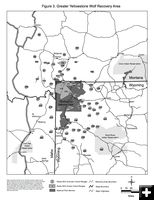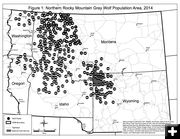

GYA
Wolf packs in the Greater
Yellowstone area.
|
|
Wolf Population Tops 1,800
by Cat Urbigkit, Pinedale Online!
April 11, 2015
Federal wolf recovery goals for wolves in the Northern Rockies call for an equitably distributed wolf population containing at least 300 wolves and 30 breeding pairs in three recovery areas within Wyoming, Montana, and Idaho. There are now a minimum of 1,800 wolves in more than 300 packs, roaming across five states (Wyoming, Montana, and Idaho, plus Oregon and Washington), according to a new report by the U.S. Fish and Wildlife Service.
Federal funding of more than $3.1 million was expended in 2014 on wolf monitoring, management, control and research, according to the Northern Rocky Mountain Wolf Recovery Program 2014 Interagency Annual Report.
Federal protections have been removed for wolves in Montana and Idaho, eastern Oregon, eastern Washington, and north central Utah. Wolves in Wyoming remain under federal protection.
Here are some of the highlights of the recently released wolf reports from each state.
Wyoming
The State of Wyoming was responsible for monitoring and managing the gray wolf population in Wyoming outside Yellowstone National Park, Wyoming (Yellowstone), and outside Tribally-owned and Native American-owned fee-titled lands within the Wind River Reservation from January 1, 2014 through September 23, 2014.
On September 23, 2014, U.S. Federal District Court in Washington, D.C. released a ruling that overturned the 2012 Wyoming wolf delisting rule. This ruling returned Endangered Species Act protections for wolves throughout Wyoming and transferred wolf monitoring and management authority back to the U.S. Fish and Wildlife Service.
As of September 23, 2014, the gray wolf population in Wyoming outside Yellowstone and Wind River Reservation remained above minimum delisting criteria.
At least 195 wolves in greater than 34 packs inhabited Wyoming outside Yellowstone and the Wind River Reservation on September 23, 2014. Pack size ranged from 2-22, and averaged 6.1 wolves/pack.
Sixteen packs successfully reproduced and raised greater than 2 pups of the year through September 23, 2014, all of which were located primarily within the Wolf Trophy Game Management Area.
Causes of mortality included: human-caused = 57 (control in response to confirmed livestock depredation = 31,
preemptive damage control in the predatory animal area = 9,
legal public harvest in the predatory animal area = 12,
vehicles = 1, illegal = 2, other = 2); natural = 3; and unknown = 3.
Seventy radio-collared wolves were being monitored as of September 23, 2014 in Wyoming outside Yellowstone and the Wind River Reservation (36% of the known population on September 23, 2014).
From 2000-2009, the wolf population in Wyoming outside Yellowstone and the Wind River Reservation increased annually, then stabilized between 200 and 250 wolves from 2010-2011. During the period of wolf population growth, wolves also expanded in range and recolonized historic areas of distribution. Through 2006, cattle depredation by wolves increased rapidly as the wolf population increased and expanded in range. Beginning in 2006, the USFWS moved to a more aggressive approach of wolf control following confirmed livestock depredation, leading to a decrease in the number of livestock losses despite a continued increase in the overall wolf population.
Wolves were confirmed to have killed 55 head of livestock (49 cattle, six sheep) in Wyoming outside Yellowstone and the Wind River Reservation from January 1 through September 23, 2014. An additional seven cattle were injured by wolves during this timeframe. Seventeen packs (50% of 34 packs in Wyoming outside Yellowstone and the Wind River Reservation) were involved in >1 depredation.
Of the 17 packs involved in >1 depredation; 13 packs (76%) were involved in >2 depredations; and nine packs (53%) were involved in >3 depredations. Thirty-one depredating wolves were lethally removed through control efforts to reduce livestock losses.
Yellowstone National Park
There were at least 104 wolves in 11 packs (9 breeding pairs) living primarily in Yellowstone National Park (YNP) through December 2014. This is an increase of nine wolves (2013 = 95 wolves) and one pack since 2013. Due to many years of being uncollared, for the first time the Bechler Pack was estimated via genetic sampling from scat samples obtained from their den site. Overall, wolf numbers have fluctuated between 83-104 wolves from 2009-2014 (excluding the low of 83 in 2012 the range is 94-104) and 6-9 breeding pairs. Pack size ranged from 2-14 and averaged 9.2. Park-wide 40 pups survived to year end, 17 on the Northern Range and 23 in the Interior with an average surviving of 4.4/pack for the 9 of 11 (82%) packs that had pups.
Wind River Indian Reservation
Wolves have been present on the reservation for at least 13 years and are currently distributed across the Wind River and Owl Creek mountain portions of the reservation. As of December 31, 2014, a minimum of 10 wolves and 1 pack (St. Lawrence) were documented on Wind River. No breeding pairs were documented on Wind River. Breeding had occurred in the St. Lawrence pack, but pups were not verified at the end of 2014.
Idaho
Biologists documented 104 packs within the state at the end of 2014. In addition, there were 23 documented border packs counted by Montana, Wyoming, and Washington that had established territories overlapping the Idaho state boundary. Additional packs are suspected but not included due to lack of documentation.
Determination of breeding pair status was made for 43 packs. Of these, 26 packs met breeding pair criteria at the end of 2014, and 17 packs did not. No determination of breeding pair status was made for the remaining 61 packs. Reproduction (production of at least 1 pup) was documented in a minimum 55 packs.
The year-end population for documented packs, other documented groups not qualifying as packs, and lone wolves was estimated at 770 wolves. Mortalities of 360 wolves were documented in Idaho in 2014, 113 wolves (24%) less than in 2013. Human-caused mortality accounted for 342 of 344 (99%) wolf mortalities during 2014 where cause of death could be determined. Legal harvest was 256 wolves, agency removal and legal take was 67 wolves, and mortality from other human causes was 19 wolves. Sixteen wolf mortalities were attributed to unknown causes and two were attributed to natural causes.
USDA APHIS Wildlife Services agents classified 43 cattle, 100 sheep, 3 dogs, and 1 horse as confirmed wolf depredations in 2014. Ten cattle, 7 sheep, and 1 dog were classified as probable wolf depredations.
Montana
The minimum count of Montana wolves decreased by 73 from 627 in 2013 to 554 in 2014. A total of 134 packs of 2 or more wolves were verified in Montana for 2014. Thirty-four packs, seven more than in 2013, qualified as a breeding pair.
USDA Montana Wildlife Services (WS) confirmed 42 livestock losses to wolves including 35 cattle, 6 sheep and 1 horse in calendar year 2014 compared to 78 total confirmed losses in 2013. Additional losses (both injured and dead livestock) most certainly occurred, but could not be confirmed. Most depredations occurred on private property.
The total number of known wolf mortalities during 2014 was 308, with 301 of these mortalities being human-related, including 213 legal harvests, 57 control actions (50 agency control and 7 under defense of property statute or under shoot-on sight-permits), 11 vehicle strikes, 10 illegal killings, 6 killed under the newly-enacted Montana State Senate Bill 200, 2 capture-related mortalities, 1 euthanized due to poor health, and 1 legal tribal harvest. In addition, 1 wolf died of natural causes and 6 of unknown causes.
Oregon
The 2014 Oregon minimum wolf population is 77 wolves. Nine packs were documented and eight of those packs met the criteria as breeding pairs. Known wolf packs occurred in parts of Baker, Jackson, Klamath, Umatilla, Union, and Wallowa Counties. In addition six new pairs of wolves were also confirmed in Oregon; five within the Eastern Wolf Management Zone and one within the Western Wolf Management Zone. 2014 marks the third year that the conservation population objective (four breeding pairs in eastern Oregon), as defined in the Oregon Wolf Conservation and Management Plan (Wolf Plan), was achieved.
Six wolves were captured and radio-collared in 2014 and throughout the year as many as 18 GPS radio-collared wolves were monitored. At year-end 13 wolves (17% of the population) were radio- collared in Oregon. Three radio-collared wolves dispersed out of state. No adult mortality or incidental take was documented in Oregon during 2014.
Confirmed depredation of livestock decreased; 11 incidents of wolf depredation were confirmed in five areas of Oregon in 2014. Per the Wolf Plan the Oregon Department of Fish and Wildlife and area producers implemented non-lethal measures to minimize depredation.
Washington
The minimum estimated wolf population in Washington increased by approximately 31% over 2013 levels to at least 68 known wolves in 16 known packs including at least 5 breeding pairs. Pack sizes ranged from 2 to 6 and averaged 3.7 wolves per pack. One pack that existed in 2013 was no longer considered a pack at the end of 2014. State and tribal biologists captured a total of 14 wolves from 9 different packs and monitored a total of 19 radio collared wolves from 11 different packs that existed at some point during 2014. We documented 10 mortalities in Washington during the year and the causes of mortality included natural causes (n = 3), human- caused (n = 4), unknown (n = 2), and agency control (n = 1).
Wolf populations were managed to ensure progress towards recovery goals while also minimizing chronic loss of livestock caused by wolves. Two cattle and 28 sheep were confirmed wolf-kills while an additional 2 cattle, 6 sheep, and 1 dog were confirmed injured by wolves. Two packs (12% of known Washington packs that existed at some point during the year) were involved in at least 1 confirmed livestock depredation. One wolf was removed during agency control actions to minimize chronic loss of livestock.
|


